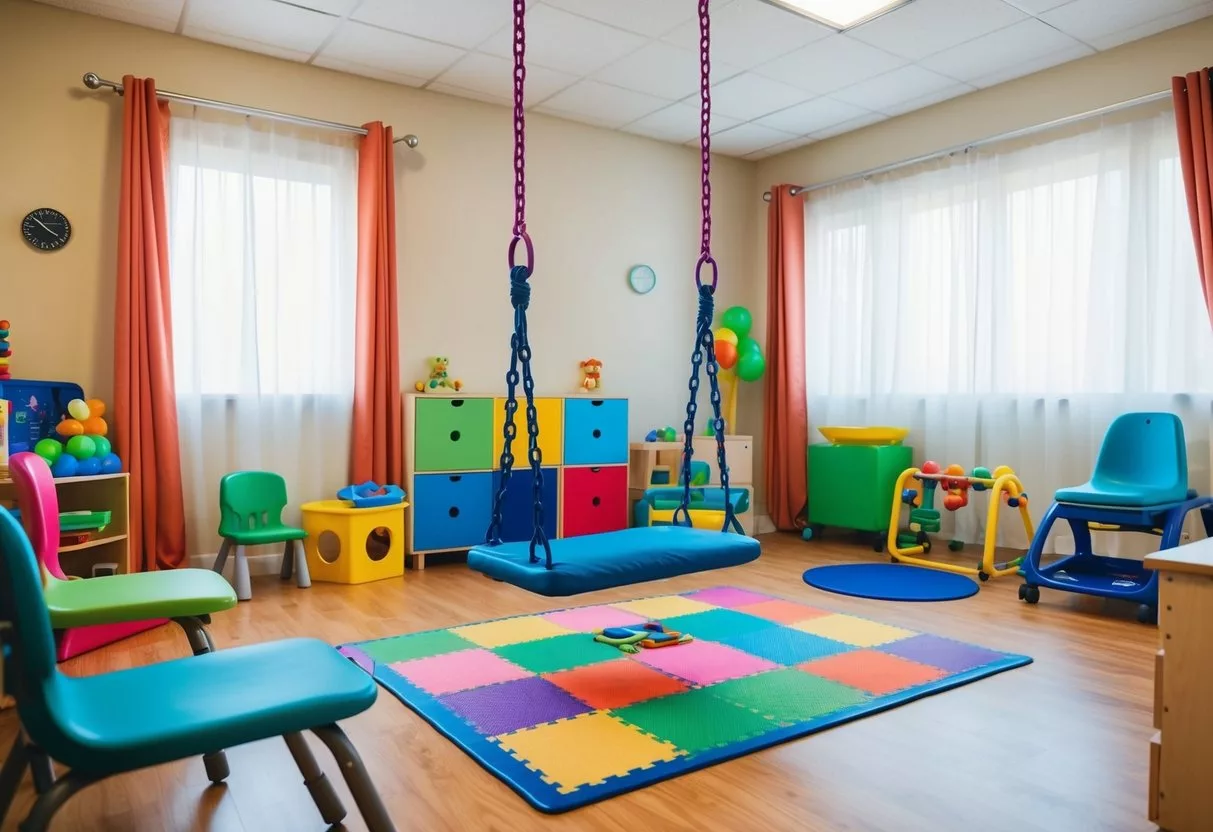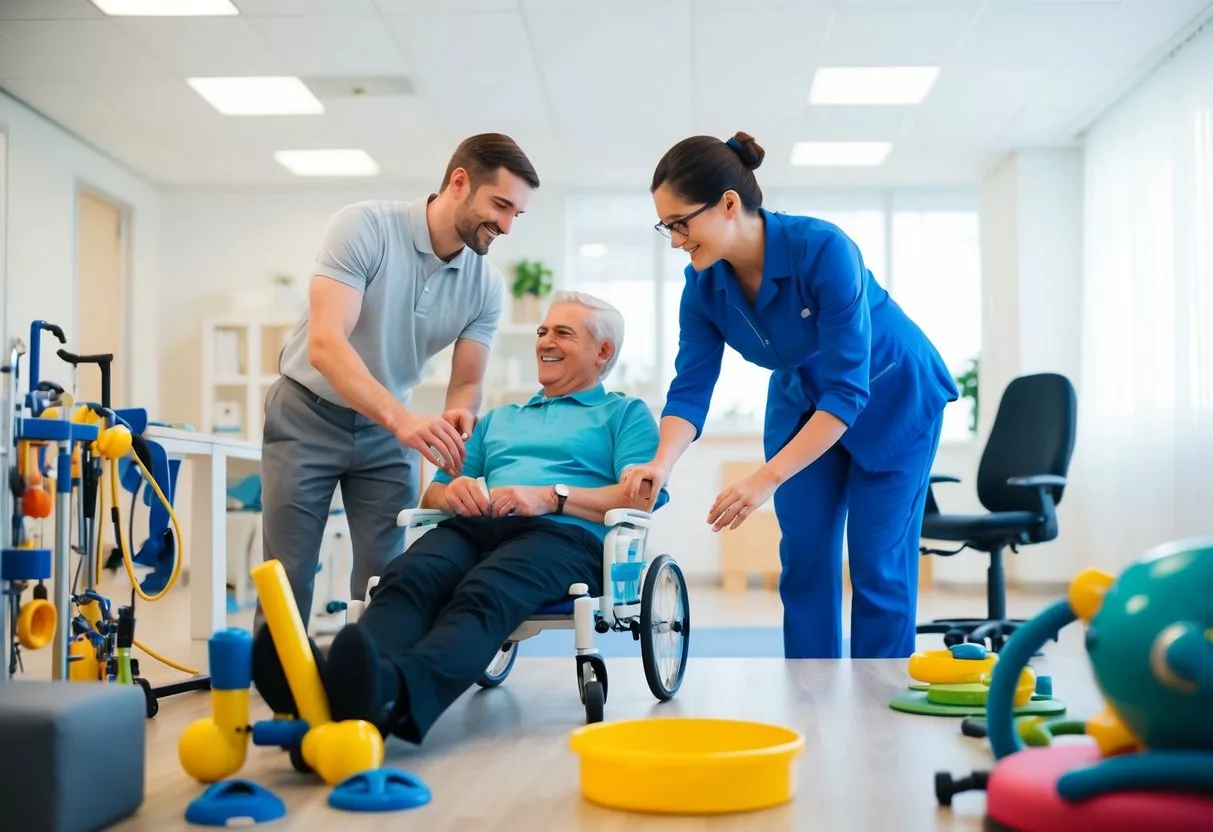Occupational therapy (OT) is a vital healthcare profession that helps people live their best lives. It focuses on enabling individuals to do the things they want and need to do every day.

OT addresses physical, emotional, and social challenges that may limit a person’s ability to function. It aims to improve quality of life by enhancing skills for work, school, self-care, and leisure activities.
Occupational therapists assess each person’s unique situation and provide tailored interventions.
The field of occupational therapy is diverse and adaptable. OTs work in various settings, including hospitals, schools, homes, and community centers.
They use exercises, equipment, and practical advice to help clients overcome obstacles and achieve independence in their daily lives.
History and Evolution of Occupational Therapy
Occupational therapy has grown from humble beginnings to become a vital healthcare field. It has shaped how we view health and daily activities.
Foundations and Growth
The roots of occupational therapy go back to the early 1900s. It began as a way to help people with mental illness. Doctors found that doing activities helped patients get better.
In 1917, the American Occupational Therapy Association was formed. This group helped make occupational therapy an official job. The field grew a lot after World War I. Many injured soldiers needed help to do daily tasks again.
By the 1960s, occupational therapy was used for all kinds of health issues. It helped people with physical and mental problems. Schools started teaching more students to become occupational therapists.
Regulation and Professional Development
As occupational therapy grew, it needed rules. In the 1930s, schools began to get approved to teach occupational therapy. This made sure all therapists learned the same important things.
The job of an occupational therapist changed over time. At first, they mostly helped in hospitals. Later, they started working in schools, homes, and community centers.
Educating new therapists became very important. Schools made better programs to teach students. They added new classes about science and health.
Today, occupational therapists must get special training. They need a college degree and a license to work. This helps make sure they give good care to patients.
Basics of Occupational Therapy

Occupational therapy helps people do important daily tasks. It focuses on improving skills and adapting environments to increase independence.
Core Concepts and Goals
Occupational therapy aims to help people take part in activities they need and want to do. The main goal is to boost health and well-being through everyday actions.
Therapists work with clients to set personal goals. These might include dressing without help or returning to work after an injury.
OT looks at the whole person. It considers physical, mental, and social needs. Therapists help people find ways to do tasks that matter to them.
Roles of Occupational Therapists
Occupational therapists assess a person’s abilities and challenges. They create tailored treatment plans to improve daily function.
They might teach new ways to do tasks or suggest tools to help. For example, they could recommend a special spoon for someone with arthritis.
Therapists also change environments to make them easier to use. This could mean adding a ramp to a home or reorganizing a workspace.
OTs work in many settings. These include hospitals, schools, and homes. They help people of all ages, from kids with disabilities to older adults needing rehabilitation.
Occupational Therapy Education and Certification

Becoming an occupational therapist requires specific education and certification. The path includes degree programs, fieldwork, and passing a national exam.
Degree Programs and Curriculums
To become an occupational therapist, students must earn a master’s degree or doctoral degree from an accredited program. These programs typically take 2-3 years to complete.
The curriculum covers topics like:
- Human anatomy and physiology
- Mental health
- Pediatric care
- Therapeutic techniques
- Research methods
Students also complete fieldwork, gaining hands-on experience in various settings. This practical training is a key part of occupational therapy education.
Many schools offer both master’s and doctoral programs. The doctoral degree often includes more advanced research and leadership training.
Licensure and Continuing Education
After finishing their degree, graduates must obtain a license to practice. This process includes passing the National Board for Certification in Occupational Therapy (NBCOT) exam.
State requirements for licensure may vary. It’s important to check with the specific state’s occupational therapy board.
Once licensed, therapists must maintain their credentials through continuing education. This ensures they stay up-to-date with the latest practices.
Professional certificates and micro-credentials are available for specialization. These can help therapists advance their careers and gain expertise in specific areas.
Ongoing education is crucial in occupational therapy. It helps therapists provide the best possible care to their clients.
The Therapeutic Process in Occupational Therapy

Occupational therapy uses a structured approach to help clients improve their daily functioning. This process involves careful assessment and the creation of tailored intervention plans.
Assessment and Evaluation
The first step in occupational therapy is a thorough assessment and evaluation. Therapists gather information about the client’s abilities, challenges, and goals. They observe the client performing tasks and may use standardized tests.
Key areas assessed include:
- Physical abilities
- Cognitive skills
- Emotional state
- Social interactions
- Home and work environments
Therapists also consider the client’s personal interests and values. This helps them understand what activities are most important to the client’s quality of life.
Developing Personalized Intervention Plans
After assessment, therapists create personalized intervention plans. These plans outline specific goals and strategies to help clients improve their daily functioning.
Intervention plans may include:
- Exercises to build strength or coordination
- Training in adaptive techniques
- Recommendations for assistive devices
- Strategies to modify tasks or environments
Therapists use evidence-based practices to guide their interventions. They regularly review progress and adjust the plan as needed.
The ultimate aim is to help clients achieve their goals and enhance their overall quality of life through meaningful activities.
Occupational Therapy Tools and Techniques

Occupational therapists use a variety of tools and methods to help patients improve their daily functioning. These include specialized equipment and targeted exercises tailored to each person’s needs.
Adaptive Equipment and Assistive Technology
Occupational therapy tools often include adaptive equipment to help patients perform everyday tasks. Some common items are:
- Dressing aids (button hooks, sock aids)
- Eating utensils with large handles
- Grab bars for bathrooms
- Wheelchair accessories
Assistive technology also plays a key role. This can include:
- Voice-activated devices
- Screen readers for computers
- Smart home systems
- Communication boards
Therapists assess each patient’s needs to find the right tools. They then teach patients how to use these devices effectively in their daily lives.
Exercises and Activities for Skill Development
Occupational therapists use targeted exercises to improve patients’ abilities. These might focus on:
- Fine motor skills (writing, buttoning clothes)
- Gross motor skills (walking, lifting objects)
- Balance and coordination
- Cognitive skills (memory, problem-solving)
Sensory integration therapy is often used for children with sensory processing issues. This can involve:
- Swings and balance beams
- Textured materials
- Light and sound tools
Therapists may also use everyday activities as part of treatment. This helps patients practice skills in real-life situations.
Patient Populations and Practice Settings

Occupational therapy serves diverse groups across various settings. Practitioners work with people of all ages to improve their ability to perform daily activities and participate fully in life.
Children and Youth Services
Occupational therapists help children with disabilities in schools and clinics. They focus on developing skills for learning, play, and self-care. For kids with autism, therapists may work on social skills and sensory processing.
Early intervention is key for young children with developmental delays. Therapists use play-based activities to build motor and cognitive skills. In schools, they help students access the curriculum and participate in classroom activities.
Pediatric occupational therapy also addresses handwriting, using assistive technology, and managing behavioral challenges. The goal is to promote independence and success in daily life.
Adult and Geriatric Care
Adult occupational therapy takes place in many settings. These include hospitals, outpatient clinics, and nursing homes. Therapists help adults recover from injuries, manage chronic conditions, and adapt to disabilities.
For the aging population, occupational therapy focuses on maintaining independence. This may involve home safety assessments, fall prevention strategies, and teaching adaptive techniques for daily tasks.
In hospitals, therapists help patients regain skills after strokes or surgeries. They may work on dressing, bathing, or meal preparation. Outpatient clinics often address work-related injuries and chronic pain management.
Occupational therapy for older adults in nursing homes aims to improve quality of life. Activities might include memory exercises, social engagement, and mobility training.
Occupational Therapy for Physical Conditions

Occupational therapy plays a crucial role in helping people with physical conditions regain independence and improve their quality of life. It focuses on enabling individuals to perform daily activities and participate in meaningful occupations.
Rehabilitating Injuries and Chronic Conditions
Occupational therapists work with patients recovering from injuries and living with chronic conditions. They help people regain strength, mobility, and function. For those with arthritis, therapists teach joint protection techniques and recommend adaptive equipment.
Patients with chronic pain learn pain management strategies and energy conservation methods. After a stroke, therapy focuses on relearning everyday tasks and improving motor skills. For individuals with diabetes, therapists provide education on foot care and safe meal preparation.
Occupational therapy also addresses mobility issues. This may include wheelchair training or teaching transfer techniques. The goal is to maximize independence in daily activities like dressing, bathing, and cooking.
Specialized Areas: Neurology, Orthopedics
In neurology, occupational therapists work with conditions like cerebral palsy and Alzheimer’s disease. They help patients maintain cognitive function and develop strategies to compensate for impairments.
For cerebral palsy, therapy may focus on improving fine motor skills and coordination.
Orthopedic occupational therapy deals with musculoskeletal injuries and conditions. This includes rehabilitation after joint replacements or fractures.
Therapists design exercise programs to improve strength and range of motion. They also teach proper body mechanics to prevent further injury.
In both areas, therapists may use splints or assistive devices to support function. They often work as part of a team with doctors and other healthcare professionals.
The ultimate aim is to promote health and enhance the patient’s ability to participate in daily life.
Occupational Therapy for Mental Health

Occupational therapy plays a key role in supporting mental health and emotional wellbeing. It helps people with mental health conditions improve their quality of life and manage daily challenges.
Psychosocial Approaches and Wellness
Occupational therapists use psychosocial approaches to help clients with mental health conditions. They focus on meaningful activities that promote wellness and recovery.
These activities might include:
• Developing coping strategies
• Practicing social skills
• Learning stress management techniques
• Improving time management
Therapists work with clients to set goals and create routines. This helps build structure and purpose in daily life.
They also address sleep and rest issues. Good sleep habits are crucial for mental health.
Therapists may suggest relaxation techniques or bedroom setup changes to improve sleep quality.
Supporting Mental Health and Emotional Wellbeing
Occupational therapy interventions aim to boost emotional wellbeing. Therapists help clients develop healthy habits and life skills.
Key areas of focus include:
• Self-care skills
• Work or school performance
• Leisure activities
• Social connections
For people with learning disabilities, therapists create tailored strategies. These might involve breaking tasks into smaller steps or using visual aids.
Therapists also teach mindfulness and relaxation methods. These tools help manage stress and anxiety.
They empower clients to take an active role in their mental health care.
Role of Occupational Therapy in Community and Society

Occupational therapy plays a vital role in improving community health and societal well-being. It focuses on helping people take part in daily activities and social roles that are important to them.
Community Integration and Participation
Occupational therapists work to improve quality of life for people of all ages in community settings. They help individuals with disabilities or health conditions join in community activities.
These therapists design programs to promote health and prevent injuries. They might teach seniors how to avoid falls at home or in public spaces.
Occupational therapy also supports people returning to work after an illness or injury. Therapists may visit workplaces to suggest changes that make jobs easier for employees with disabilities.
In schools, occupational therapists help students with special needs take part in classroom activities. They work with teachers to create inclusive learning environments.
Advocacy and Accessibility
Occupational therapists are strong advocates for accessible communities. They push for changes that allow everyone to participate fully in society.
These professionals consult on building designs to ensure spaces are usable by people with different abilities. They might suggest wider doorways or lower counters in public buildings.
Therapists also educate community members about disabilities and health conditions. This helps reduce stigma and promotes understanding.
They work with local governments to create policies that support inclusion. This could include advocating for more accessible public transportation or recreational facilities.
Occupational therapists also help develop community programs that offer meaningful activities for diverse groups. These might include art classes for seniors or adaptive sports for children with disabilities.
Advancements and Future Directions in Occupational Therapy
New technologies and research are changing how occupational therapists help people. These changes are making treatment better and reaching more patients who need help.
Research and Innovation
Telehealth is growing in occupational therapy. It lets therapists treat patients from far away. This helps more people get care, even if they live in rural areas.
Virtual reality is becoming a useful tool. Therapists use it to create safe places for patients to practice skills. This works well for people with brain injuries or developmental disorders.
Wearable technology is helping track patient progress. Devices can measure things like hand strength or movement. This gives therapists more accurate data to plan treatments.
Evidence-based practice is getting stronger. New research helps therapists choose the best treatments for each patient.
Interdisciplinary Collaboration
Occupational therapists are working more with other health professionals. This team approach helps patients get better care.
In healthcare settings, OTs work with doctors, nurses, and physical therapists. Together, they create complete treatment plans for patients.
For people with low vision, OTs team up with eye doctors. They help patients use assistive technology to do daily tasks.
In schools, OTs collaborate with teachers and psychologists. This helps kids with developmental disorders get the right support.
New assessment tools are making it easier for teams to work together. These tools help everyone understand a patient’s needs better.
Frequently Asked Questions
Occupational therapy helps people of all ages participate in daily activities. It treats various conditions and uses different interventions than physical therapy.
What does an occupational therapist do?
An occupational therapist helps people do everyday tasks. They work with patients who have injuries, illnesses, or disabilities.
Occupational therapists create customized treatment plans to improve a person’s ability to perform daily activities. They may modify environments or teach new skills to increase independence.
What conditions does occupational therapy treat?
Occupational therapy treats many conditions. These include developmental delays, autism, stroke, and arthritis.
It also helps people with mental health issues, spinal cord injuries, and brain injuries. Occupational therapists work with patients who have hand injuries or chronic pain too.
How does occupational therapy differ from physical therapy?
Occupational therapy focuses on helping people do daily tasks. Physical therapy aims to improve movement and reduce pain.
Occupational therapists may work on skills like dressing or cooking. Physical therapists often focus on exercises to strengthen muscles or improve balance.
What are some common interventions used in occupational therapy?
Occupational therapists use many techniques. They may teach patients how to use adaptive equipment like special utensils or dressing aids.
They often do activities to improve fine motor skills or hand strength. Therapists might also suggest changes to a person’s home or workplace to make tasks easier.
What are the educational requirements for becoming an occupational therapist?
Occupational therapists need a master’s degree in occupational therapy. Some get a doctoral degree.
They must also pass a national exam and get a state license. Many occupational therapists complete continuing education to keep their skills current.
What are the benefits of occupational therapy for children?
Occupational therapy helps children develop important skills. It can improve a child’s ability to play, learn, and take care of themselves.
For kids with disabilities, occupational therapy may help them participate more fully in school and social activities. It can also help children improve their handwriting or use of school tools.